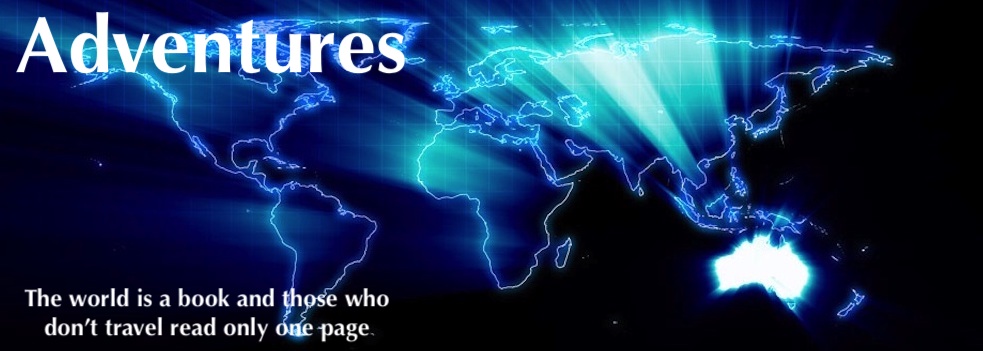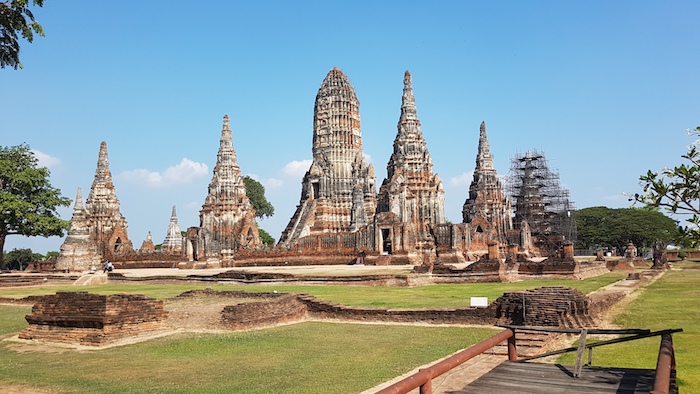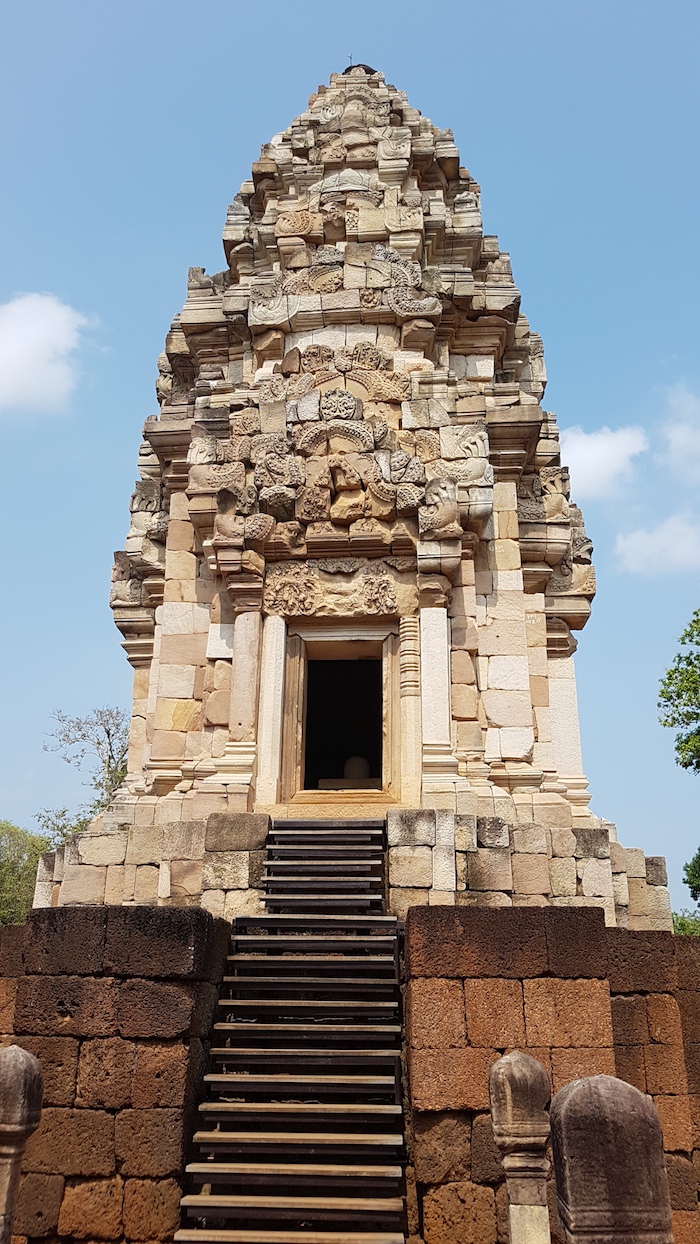The Khmer Empire prevailed in what is now northern Cambodia. It grew out of the former civilisation of Chenla and lasted from 802 to 1431. It is known as the Angkor period, after the empire’s most well-known capital, Angkor. The Khmer Empire ruled or subordinated most of mainland Southeast Asia and stretched as far north as southern China.
The empire was in decline from 1296 until its final defeat in 1431.
Angkor Wat
Angkor Wat is the world’s largest temple. It was initially a Hindu temple and then became a Bhuddist place of worship. Pragmatism in action. The initial design and construction took place in the first half of the 12th century.
- Just one part of the massive Angkor Wat.
More photographs and information from an extended trip to Angkor Wat in Cambodia.
Ayutthaya – Ancient Capital
The city of Ayutthaya is about 80 kilometres north of Bangkok. It was the capital of the Kingdom of Siam, and a prosperous international trading port, from 1350 until razed by the Burmese in 1767. The ruins of the old city now form the Ayutthaya Historical Park, an archaeological site that contains palaces, Buddhist temples, monasteries and statues. The park is on an island between three rivers.
It has been declared a UNESCO World Heritage Site of Outstanding Universal Value.
- The capital of Siam, in 1700 Ayutthaya was home to a million people and was the largest city in the world.
We visited Autthaya on a day trip out of Bangkok.
Prasat Hin Khao Phanom Rung
- Prasat Hin Khao Phanom Rung
We visited Prasat Hin Khao Phanom Rung on our tour of the South East Corner of Thailand.
Prasat Khao Lon
Prasat Khao Lon may be in a permanent state of “undergoing restoration”. It is little known and difficult to find.
- The pathway to Prasat Khao Lon, Thap Rat District, Sakeo Province.
More information and photographs.
Prasat Khao Lon was visited on the Isaan Road Trip during Songkran.
Prasat Phnom Wan, Korat
Prasat Phnom Wam, built between the 9th and 11th century, is the fifth largest Khmer Hindu temple in Thailand.
It was first constructed as a Hindu temple and later adapted into a Buddhist temple with construction continuing to the 14th century but apparently never being completed. However, this Prasat may be older still. Evidence from archeological work reveals it was built on a pre-historic site dating to 500BCE.
It would seem that the Hindu temple was abandoned during regime power struggles before being adopted as a Buddhist temple in the 13th-14th centuries. Such pragmatism was routine.
- Prasat Phnom Wan’s entry gopura faces east and is flanked by two false doors. Not the lighter-coloured replacement sandstone blocks
More Information and Photographs
We visited Prasat Phnom Wan on the way to our South Thailand Road Trip Cut Short.
Prasat Phra Yuen, Khon Kaen
A small, disjointed collection of stones, rather than an ancient ruin, that is now used as a Buddhist temple.
- Prasat Phra Yuen
We visited Prasat Phra Yuen during a day trip to Thailand’s Stonehenge.
Prasat Phum Phon
Phum Pon is one of the oldest Khmer style Prasats in Thailand.
It was probably originally a Hindu temple devoted to the god Shiva, built of bricks. A stone inscription with south Indian and Sanskrit characters dating back to 7th-8th century was excavated on the site.
Prasat Phum Pon consisted of four structures. The only one remaining is in relatively complete condition. It is in the pre-Angkoran style. To the north of the remaining tower is a structure of which only the base and door frames are present. To the south of the remaining tower is a laterite base. It was probably an open pavilion with a tiled roof.
Further removed from the main tower is the remains of a square building where a lintel from Prei Kmeng (pre-Khmer) times was found.
- Prasat Phum Pon
We visited Prasat Phum Pon on our tour of the South East Corner of Thailand.
Prasat Prang Ku
Prasat Prang Ku consisted of three sanctuaries, extant but failing, aligned north-south on the same laterite base that faces east. The Prasat was surrounded by a moat. It has been dated to the 12th century and was built in the Angkor Wat style.
- Prasat Prang Ku
We visited Prasat Prang Ku on our tour of the South East Corner of Thailand.
Prasat Phimai Historical Park
- Prasat Phimai
We visited Phimai Historical Park on our tour of the South East Corner of Thailand.
Prasat Si Khoraphum
This Hindu religious sanctuary was constructed in the Baphoun school of Khmer art of the 11th-12th centuries. It was converted to a Bhuddist temple in the 16th century as evidenced by the roof structures of the prangs.
It features a brick tower on a laterite platform.
- Prasat Si Khoraphum
We visited Prasat Si Khoraphum on our tour of the South East Corner of Thailand.
Prasat Ta Muen
- Prasat Ta Muen
We visited Prasat Ta Muen on our tour of the South East Corner of Thailand.
Prasat Ta Muen Thom (on Cambodian border)
Prasat Ta Muen Thom was built in the 11th century. It faces south and comprises a principal tower and two minor towers, two libraries, a pond, and a boundary wall with four entrances.
- Prasat Ta Muen Thom
We visited Prasat Ta Muen Thom on our tour of the South East Corner of Thailand.
Prasat Ta Muen Tot
This Khmer sanctuary was built in the 13th century in the Bayon style of Khmer architecture. It was the chapel for a rest house in Mahayana Buddhism. It is made of sandstone and laterites.
The main Prasat was a rectangular building facing east. It has entrances on the east and west sides, five windows on the south side but no windows on the north side.
- Prasat Ta Muen Tot
We visited Prasat Ta Muen Tot on our tour of the South East Corner of Thailand.
Phrathat Yakhu, Kalasin
Phrathat Yakhu is a chedi/stupa from the Dvaravati period. It is situated in the middle of a field, north of Baan Sema, in the Kamalasai district. It was the largest chedi in the ancient Khmer city of Fa Daet Song Yang.
- The chedi showing one of the boundary stones.
More information and more photographs
Si Thep Historical Park
Si Thep Historical Park is in Petchabun Province, Central Thailand.
The ancient city of Si Thep was a Mon-Khmer town inhabited from around the third to fifth century until the thirteenth century. It became abandoned around the time the Thai-speaking cities of Sukhothai and later Ayutthaya emerged as new centres of power.
The World Heritage Site covers an area of 866 hectares. Despite this large area there are only three structures extant within the Inner City (two prangs and a ‘khao’) and two outside the Inner City (one prang and a ‘khao’).
- Prang Song Phi Nong
More information and photographs.
Sadok Kok Thom Historical Park
Prasat Sadok Kok Thom is the biggest temple/castle in East Thailand and one of the oldest in modern day Thailand.
- Main part of Sadok Kok Thom.
More information and photographs.
Sadok Kok Thom was part of the itinerary on the Isaan Road Trip during Songkran.
Sukothai Historical Park
Sukhothai was declared a World Heritage City in 2005. It is home to a vast number of historical sites and temple ruins. As the first capital of Siam, the Sukhothai Kingdom (1238 – 1438) was the cradle of Thai civilisation – the birthplace of Thai art, architecture and language.
- Wat Mahathat
More information and photographs.
We visited Sukothai Historical Park during our North Central Thailand Road Trip.
Wat Ku Kaew, Khon Kaen
A small interesting Khmer ruin outside Khon Kaen.
We visited Wat Ku Kaew during a day trip to Thailand’s Stonehenge.
Wat Ku Mithila, Maha Sarakham
It would appear that a relatively modern structure has been made on an old base to protect five ancient figures carved from laterite.
- Wat Ku Mithila
Wat Phou (Vat Phou), Laos
Wat Phou lies at the base of Phou Kao Mountain, overlooking the Mekong River. The ancient Khmer temple complex is a World Heritage Site, built between the 5th and 15th centuries. Wat Phou is one of the largest archaeological sites in Laos. Its oldest structure is a sandstone temple dating back to the 5th century.
- Wat Phou
More information and photographs.
We travelled to Vat Phou during our visit to Pakse, Laos.
Wat Po Chai
An early construction (possibly a temple) has been preserved at Wat Po Chai. It is architecturally different to other contemporary and proximate Thai structures but no other information is available.
- Old structure at Wat Po Chai.
We visited Wat Po Chai during our Sea of Clouds Road Trip.
© Kim Epton 2023-2024
1370 words, yy photographs, zz images.
Feel free to use any part of this document but please do the right thing and give attribution to adventures.net.au. It will enhance the SEO of your website/blog and Adventures.
See Terms of Use.






















